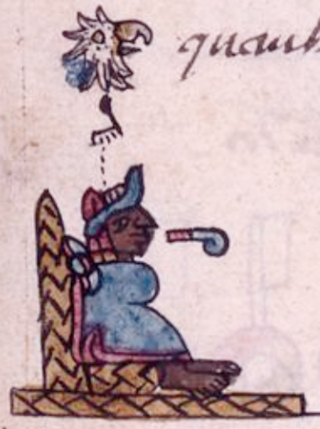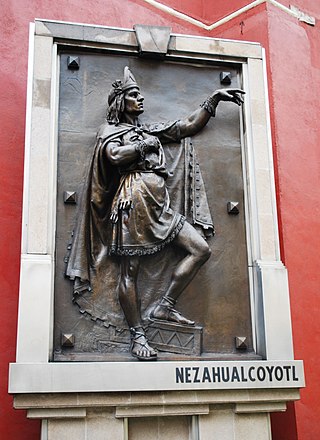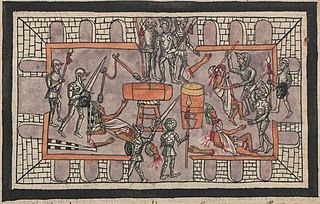Plot
In 1529, the Bishop of the See of New Spain, Juan de Zumárraga, receives a request from King Carlos of Spain to collect information regarding the indigenous population and their culture. The Bishop reluctantly employs Chicóme-Xochitl Tliléctic Mixtli ("Seven-Flower Dark Cloud"), an elderly Mexíca man, for the task of narrating his biography to be transcribed by the monks of Mexico City and sent to Spain.
Born to ordinary parents on the island of Xaltocan in 1466, Mixtli describes the traditions, politics, and practices of the Triple Alliance. At the age of four, he accompanied his father, a stonemason, to Tenochtítlan to transport a sunstone for the central plaza. In his youth, Mixtli also engaged in an incestuous sexual relationship with his sister Tzitzilíni. In school, Mixtli befriended Chimáli and Tlatli, who began a sexual relationship of their own. At these schools, the boys are taught to fight and read, but Mixtli's eyesight hinders his progress. Upon the completion of his education, Mixtli receives an invitation from their governor Lord Red Heron to work in the palace of Nezahualpíli, the Uey-Tlatoáni of Texcóco as a scribe. There, he befriended his own slave Cozcatl. During his time there, he uncovers a conspiracy that leads to Tlatli's death, enraging Chimáli. At this time, Ahuítzotl completes the construction of the Great Pyramid and hopes to engage in a Flowery War with Texcóco to celebrate human sacrifices.
Mixtli participates in this Flowery War, collecting enough prisoners of war to sacrifice to the sunstone. While Mixtli visits a menagerie and a collection of people with deformities, Chimáli emasculates Cozcatl. Mixtli earns from Ahuítzotl a career as a pochtécatl, travels through multiple regions, and returns with valuable goods to sell. At a celebration of the merchants' return, Mixtli learns from a "cocoa-bean man" (who had visited him long before, implied to be an old Aztec god) that Tzitzilíni was tortured and mutilated in his absence. In mourning, he flees Tenochtítlan to the village of the Cloud People who speak Zapotec. Mixtli invites Zyanya to a Huave village of cannibals to steal their stash of valuable purple dye. Zyanya and Mixtli fall in love and marry in Tenochtítlan, though present at the ceremony is Chimáli, now a member of Ahuítzotl's court. Enraged, Mixtli challenges him to a duel, which ends in Cozcatl removing Chimáli's eyes and tongue. Zyanya gives birth, and they call their daughter Cocóton. During this time, Ahuítzotl unveils a new aqueduct in Tenochtítlan, but a flood levels the island and destroys people's homes. Though Mixtli's home is undamaged, Zyanya vanishes in the water, never seen again. In mourning, Mixtli leaves his daughter to Cozcatl and his wife while he wanders north, where he encounters a Rarámuri village under attack by Yaki bandits.
He returns to Tenochtítlan to find Ahuítzotl dead and the vainglorious Motecuzóma newly coronated, who assigns Mixtli to develop a town in Michihuácan territory with several settlers and priests. After they arrive, the priests brutally sacrifice Cocotón to Xipe Totec, and Mixtli orders his soldiers to rape and kill the settlers. Upon their return to Tenochtítlan, Mixtli marries Béu Ribé, Zyanya's estranged sister, only to immediately depart for the northern deserts to find the legendary Aztlan. He encounters Chichimeca nomads, who direct him to the area of Sinalobóla, where he finds a wasteland swamp inhabited by the Aztéca people. Mixtli teaches the tribal leader (tlatocapíli) about Tenochtítlan and negotiates a potential alliance with their own sunstone. Tired of his journeys, Mixtli heads home and stops at Teotihuácan, where he encounters Motecuzóma, who informs him of some mysterious omens from the southern Maya countries. There, Mixtli meets with a Xiu lord hosting two shipwrecked Spaniards who refuse to leave their chambers. After much prying, the Spaniards (Gonzalo Guerrero and Jerónimo de Aguilar) agree to explain their presence, having arrived from a Spanish colony in Cuba. At this time, Nezahualpíli died, but his heir Black Flower was usurped when Nezahualpíli's other son and Motecuzóma's ally Cacáma assumed the throne in Texcóco.
Colonists from Cuba arrive in Totonáca country, among them Hernán Cortés and Pedro de Alvarado, who employ de Aguilar and an ambitious slave named Ce-Malináli to interpret for them. Motecuzóma, convinced the white men are gods, does little to deter the approach of the Spanish. Despite their encroaching on surrounding cities, Motecuzóma expresses indecision, prompting Mixtli and the court of Tenochtítlan to develop a conspiracy against him. Spanish forces arrive at Tenochtítlan, and Motecuzóma sympathizes with their campaign, even allowing them to execute his own pochtecatl and agrees to supply them with the nation's treasury of gold. Frustrated, the citizens of Tenochtítlan participate in a massacre against Spanish forces, while Hernán Cortés heads east to settle a criminal charge. The revolt fails, and Hernán Cortés prompts Motecuzóma to placate his people. When he steps onto his platform, they hurl stones at him and knock him unconscious. In the infirmary, Mixtli finds that he survived and stabs him, finally killing him and naming Cuitláhuac his successor, who orders his people to launch a greater attack on the Spanish, who flee the city. The citizens of Tenochtítlan fail to recuperate entirely, suffering from smallpox, cholera, and the plague, and once the Spanish recover, they launch a final attack on Tenochtítlan that levels the city to ashes and force the surviving Mexíca to rebuild the city in the Spanish style. The elderly Mixtli finds employment with Cortés and witnesses the hanging of the final three tlahtohqueh, which he considers the end of the Triple Alliance.
In 1531, with the completion of his biography, the Bishop of Mexico prosecutes Mixtli for heresy, despite the king's delayed request to grant Mixtli and Béu Ribé a pension (though it's implied that the Bishop ignored the request entirely). Mixtli makes no defense and accepts his execution by immolation.
Historical accuracy
The novel faithfully recreates a great deal of historical geographic places and history, particularly that involving the Spanish conquest of the Aztec empire in an expedition led by Hernán Cortés. Jennings, through Dark Cloud, presents generally accurate portrayals of the events surrounding a number of actual historical figures, their names usually rendered in traditional Nahuatl. This includes descriptions of many rulers ("Revered Speakers") of many civilizations, such as Ahuizotl and Moctezuma II of the Mexíca, Nezahualpilli of the Acolhua or Patzínca of the Totonac, La Malinche (rendered Cé-Malinali, "One Grass" in Nahuatl, and later self-proclaimed "Lady Grass", Malintzin), the shipwrecked Gerónimo de Aguilar and Gonzalo Guerrero, as well as Hernán Cortés himself and many of his retinue.
The novel's narrator maintains a voice of careful criticism of Spanish authorities throughout the novel. Though he professes himself a Christian, much of the novel is devoted to detailed discourse regarding Aztec religion, including a great deal of information regarding the gods Quetzalcoatl, Tlaloc, Huitzilopochtli, Tonatiuh, and especially Ehecatl. The novel also does not shy from depictions of ritual human sacrifice. Throughout the novel, Mixtli criticizes not only Christianity, but also the Spaniards' hypocrisy in espousing Christianity while simultaneously engaging in acts of great violence and degradation toward the native populations.

Ahuitzotl was the eighth Aztec ruler, the Huey Tlatoani of the city of Tenochtitlan, son of princess Atotoztli II. His name literally means "Water Thorny" and was also applied to the otter. It is also theorized that more likely, the animal called ahuitzotl is actually the water opossum, the hand symbolizing its prehensile tail, which otters notably lack.

Cuitláhuac or Cuitláhuac was the 10th Huey Tlatoani (emperor) of the Aztec city of Tenochtitlan for 80 days during the year Two Flint (1520). He is credited with leading the resistance to the Spanish and Tlaxcalteca conquest of the Mexica Empire, following the death of his kinsman Moctezuma II.

Cuauhtémoc, also known as Cuauhtemotzín, Guatimozín, or Guatémoc, was the Aztec ruler (tlatoani) of Tenochtitlan from 1520 to 1521, making him the last Aztec Emperor. The name Cuauhtemōc means "one who has descended like an eagle", and is commonly rendered in English as "Descending Eagle", as in the moment when an eagle folds its wings and plummets down to strike its prey. This is a name that implies aggressiveness and determination.

Hernán Cortés de Monroy y Pizarro Altamirano, 1st Marquess of the Valley of Oaxaca was a Spanish conquistador who led an expedition that caused the fall of the Aztec Empire and brought large portions of what is now mainland Mexico under the rule of the king of Castile in the early 16th century. Cortés was part of the generation of Spanish explorers and conquistadors who began the first phase of the Spanish colonization of the Americas.

Motecuhzoma Xocoyotzin, referred to retroactively in European sources as Moctezuma II, was the ninth Emperor of the Aztec Empire, reigning from 1502 or 1503 to 1520. Through his marriage with Queen Tlapalizquixochtzin of Ecatepec, one of his two wives, he was also king consort of that altepetl.

Tenochtitlan, also known as Mexico-Tenochtitlan, was a large Mexican altepetl in what is now the historic center of Mexico City. The exact date of the founding of the city is unclear, but the date 13 March 1325 was chosen in 1925 to celebrate the 600th anniversary of the city. The city was built on an island in what was then Lake Texcoco in the Valley of Mexico. The city was the capital of the expanding Aztec Empire in the 15th century until it was captured by the Tlaxcaltec and the Spanish in 1521.

The Aztecs were a Mesoamerican culture that flourished in central Mexico in the post-classic period from 1300 to 1521. The Aztec people included different ethnic groups of central Mexico, particularly those groups who spoke the Nahuatl language and who dominated large parts of Mesoamerica from the 14th to the 16th centuries. Aztec culture was organized into city-states (altepetl), some of which joined to form alliances, political confederations, or empires. The Aztec Empire was a confederation of three city-states established in 1427: Tenochtitlan, city-state of the Mexica or Tenochca, Texcoco, and Tlacopan, previously part of the Tepanec empire, whose dominant power was Azcapotzalco. Although the term Aztecs is often narrowly restricted to the Mexica of Tenochtitlan, it is also broadly used to refer to Nahua polities or peoples of central Mexico in the prehispanic era, as well as the Spanish colonial era (1521–1821). The definitions of Aztec and Aztecs have long been the topic of scholarly discussion ever since German scientist Alexander von Humboldt established its common usage in the early 19th century.

Nezahualcoyotl was a scholar, philosopher (tlamatini), warrior, architect, poet and ruler (tlatoani) of the city-state of Texcoco in pre-Columbian era Mexico. Unlike other high-profile Mexican figures from the century preceding Spanish conquest of the Aztec Empire, Nezahualcoyotl was not fully Mexica; his father's people were the Acolhua, another Nahuan people settled in the eastern part of the Valley of Mexico, on the coast of Lake Texcoco. His mother, however, was the sister of Chimalpopoca, the Mexica king of Tenochtitlan.

The Massacre in the Great Temple, also called the Alvarado Massacre, was an event on May 22, 1520, in the Aztec capital Tenochtitlan during the Spanish conquest of the Aztec Empire, in which the celebration of the Feast of Toxcatl ended in a massacre of Aztec elites. While Hernán Cortés was in Tenochtitlan, he heard about other Spaniards arriving on the coast – Pánfilo de Narváez had come from Cuba with orders to arrest him – and Cortés was forced to leave the city to fight them. During his absence, Moctezuma asked deputy governor Pedro de Alvarado for permission to celebrate Toxcatl (an Aztec festivity in honor of Tezcatlipoca, one of their main gods. After the festivities had started, Alvarado interrupted the celebration, killing all the warriors and noblemen who were celebrating inside the Great Temple.

The fall of Tenochtitlan, the capital of the Aztec Empire, was an important event in the Spanish conquest of the empire. It occurred in 1521 following extensive negotiations between local factions and Spanish conquistador Hernán Cortés. He was aided by La Malinche, his interpreter and companion, and by thousands of indigenous allies, especially Tlaxcaltec warriors.

The Aztec Empire or the Triple Alliance was an alliance of three Nahua city-states: Mexico-Tenochtitlan, Tetzcoco, and Tlacopan. These three city-states ruled that area in and around the Valley of Mexico from 1428 until the combined forces of the Spanish conquistadores and their native allies who ruled under Hernán Cortés defeated them in 1521.

The Aztecs were a Pre-Columbian Mesoamerican people of central Mexico in the 14th, 15th, and 16th centuries. They called themselves Mēxihcah.

The Spanish conquest of the Aztec Empire was a pivotal event in the history of the Americas, marked by the collision of the Aztec Triple Alliance and the Spanish Empire, ultimately reshaping the course of human history. Taking place between 1519 and 1521, this event saw the Spanish conquistador Hernán Cortés, and his small army of soldiers and indigenous allies, overthrowing one of the most powerful empires in Mesoamerica.

The Codex Azcatitlan is an Aztec codex detailing the history of the Mexica and their migration journey from Aztlán to the Spanish conquest of the Aztec Empire. The exact date when the codex was produced is unknown, but scholars speculate it was crafted some time between the mid-16th and 17th centuries. The name of this important Mexica pictorial manuscript was suggested by its first editor, Robert H. Barlow, who erroneously interpreted the anthill on page 2 as the glyph for “Aztlán.” In the Bibliothèque nationale de France, where it is housed, it is known as Histoire mexicaine, [Manuscrit] Mexicain 59–64.

The Mexica are a Nahuatl-speaking people of the Valley of Mexico who were the rulers of the Triple Alliance, more commonly referred to as the Aztec Empire. The Mexica established Tenochtitlan, a settlement on an island in Lake Texcoco, in 1325. A dissident group in Tenochtitlan separated and founded the settlement of Tlatelolco with its own dynastic lineage. In 1521, their empire was overthrown by an alliance of Spanish conquistadors and rival indigenous nations, most prominently the Tlaxcaltecs. The Mexica were subjugated under the Spanish Empire for 300 years, until the Mexican War of Independence overthrew Spanish dominion in 1821. In the 21st century, the government of Mexico broadly classifies all Nahuatl-speaking peoples as Nahuas, making the number of Mexica people living in Mexico difficult to estimate.

Tecoaque is a Mesoamerican archaeological site, located in western Tlaxcala state, central Mexico, close to Calpulalpan. The site was inhabited by the Acolhua, one of the three ethnic groups making up the Aztec Empire. Tecoaque had many white-stucco temples and was the home to approximately 5,000 people, mostly priests and farmers.

The Third Letter of Relation of Hernán Cortés to the Emperor Carlos V is one of five letters written by the Spanish conquistador Hernán Cortés to the emperor Carlos V, sent with the intention of informing Carlos V of the territories discovered and their conquest; it was signed on 15 May 1522 in Coyoacán. The letter describes part of the expedition to the New World, the conquest of Tenochtitlán and the destruction of the city, covering the events from 1520 until the final conquests in 1522.
Xicomecoatl, Chicomácatl, or as he was referred to as by the Spanish conquistador Bernal Díaz del Castillo, "Cacique Gordo", was the ruler of the city of Cempoala while it was under control of the Mexica Empire.

The Battle of Colhuacatonco was fought on 30 June 1521 during the late stages of the Siege of Tenochtitlan between Spanish-Tlaxcalan forces and the Mexica Empire. It is regarded as the most important victory achieved by the Mexica during the siege.

















